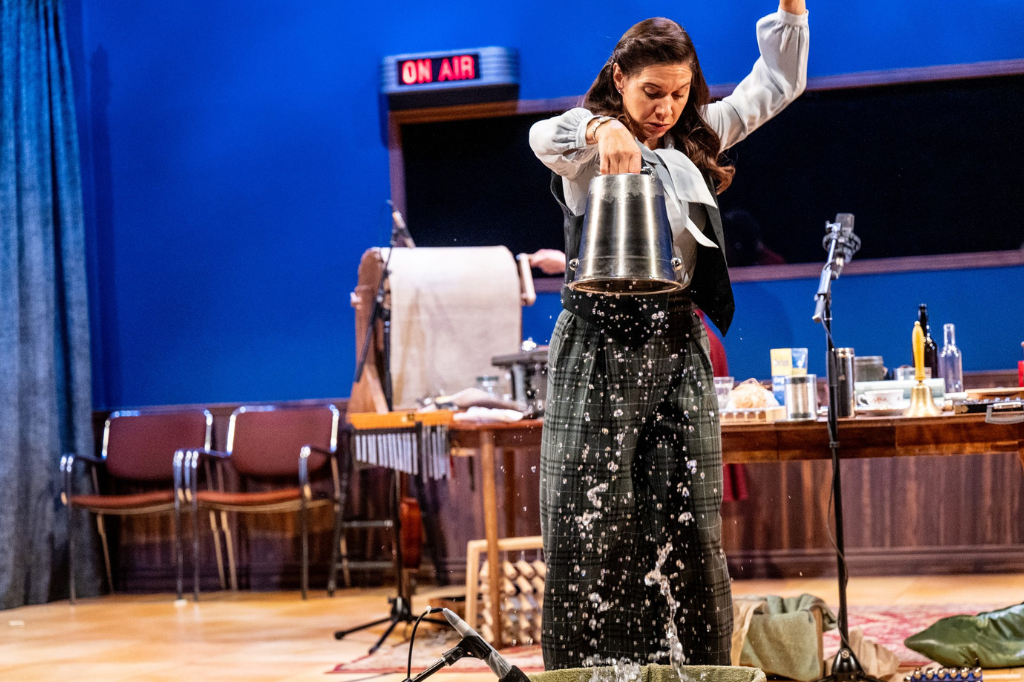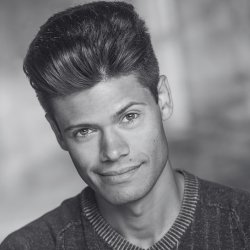It’s a Wonderful Life: A Live Radio Play makes theatre magic with… celery
This holiday season, Toronto’s Young People’s Theatre is echoing with sounds of laughter, wonder — and celery.
This crunchy vegetable is one of a collection of whacky, whimsical props being used to create the soundscape of Young People’s Theatre’s current production, It’s a Wonderful Life: A Radio Play.
Adapted by Joe Landry from the beloved 1946 film — itself an adaptation of a short story — the play follows the life of George Bailey, a man who has sacrificed his own dreams to make the small town of Bedford Falls where he lives a better place.
In a moment of crisis, George receives a visit from a guardian angel named Clarence. Kindly and hapless, Clarence shows George a vision of what life would be like in Bedford Falls if George had never existed. George returns to reality with a new appreciation for his family, his community, and life itself.
Landry’s adaptation adds a layer of theatre magic to this timeless tale. In his play, set in a sound studio in the 1940s, a cast of five performs the story of It’s A Wonderful Life as a live radio broadcast. Not only does this small ensemble play all the characters — they also double as Foley artists. In other words, they create their own sound effects, in real time, right in front of our eyes.
“I brought a bunch of sounds and said, this is how you do some of them,” said John
Gzowski, the show’s sound designer and Foley consultant. “Then [I] left a bunch of junk lying around saying, go ahead and see what you can come up with.”
According to Herbie Barnes, who is both the artistic director of YPT and It’s a Wonderful Life’s director., the cast — comprised of dazzling talents Caitlyn MacInnis, Amy Matysio, Shaquille Pottinger, Anand Rajaram, and Cliff Saunders — more than rose to the challenge.
“Anand came up with this idea about a bell chime,” he said. “[Anand] goes, ‘What if I make [a] hat with the chimes on the hat, and I have to keep my head really steady until we want the chimes?’ The next morning he shows up with this hat made, and it was brilliant. We didn’t use it, but…he wore it for the opening night party.”
For Gzowski’s part, this is his fifth time working on It’s a Wonderful Life: A Radio Play — but he always finds new details to add. “If [the script says] door slam, it’s like…what kind of door?” said Gzowski. “What’s the room you’re going into? Are there other sounds in the room happening at the same time?”
This richness of detail is where props like celery come in. “You crunch [celery] and that’s your ice breaking sound,” explained Gzowski. I asked him if there’s a Foley effect that he’s particularly excited for audiences to experience.
“There’s a fair amount of cars in the script,” he answered. “I took an old sewing machine motor…and put a hose clamp on the end so it was out of balance — so it would rattle as it went around — and then put it loosely on the [Foley] table. So the whole thing kind of rattles and [the cast] can control the speed of it, and it sounds a bit like an old car that way.”
That’s only one part of the sound effect. The cast also uses a “wooden ratchet to do the gear shift, a hot water bottle with a metal plate for windshield wipers, [and] a fridge door that makes an excellent car door sound.”
The magic happens when “you do it in sequence all together,” which “makes it more of a performance,” said Gzowski. With so many moving parts, this one sound effect takes the whole cast to complete.
What happens when you combine this virtuosic Foley work with a huge cast of characters? Glorious pandemonium.
“[An actor will] turn around and play two different characters having a conversation with themselves,” said Barnes, “and then they’re back into making the Foley…[W]atching the dance that these actors have made is just so much fun.”
According to Gzowski, the play’s multiple layers are what make this version of It’s a Wonderful Life unique — and uniquely theatrical.
“Theatre magic is really fun when you can see the trick, it’s a really simple trick, and the trick works…If you take a box of cornstarch [and] you go ‘crunch, crunch, crunch,’ I see you do it, but I [also] hear someone walking in snow…[I] get both the stories.”
In other words, live Foley encourages audiences to use their imaginations, transforming them from spectators into collaborators who help bring a story to life.
But why this story in the first place?
“When we book a season, we think about where young people are in their lives,” said Barnes. Both he and YPT’s executive director Nancy Webster noticed a lack of hope, and a pervasive sense of disconnectedness, in the young people around them.
“What we were noting is that young people had forgotten that they’re part of a community,” said Barnes. “Not [just] young people, all people, were getting a little bit selfish. They were like ‘out of my space’…There [were] a lot of mental health issues.”
Amidst this grim atmosphere, Barnes hopes that It’s a Wonderful Life will remind young people “of community…that we’re in this world together and that we need to be with each other,” and “that even the little bit of work that they do changes people’s lives.”
Barnes is also optimistic about It’s a Wonderful Life’s potential to bring different generations together. “We were very poor growing up,” recalled Barnes of his own childhood. “We had one TV in the house. So when we wanted to watch a program, it had to be a program that we could all enjoy. So we would watch these classic movies together, because it was something we could all identify with.”
“It’s not a Christmas play,” said Barnes. “It’s a human play about who we are and how we can be with each other.”
Young People’s Theatre opened It’s a Wonderful Life: A Live Radio Play on November 20. The production runs until December 30. You can learn more about the production here.











Comments